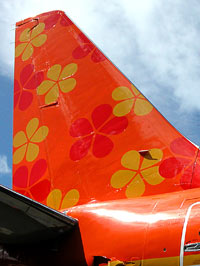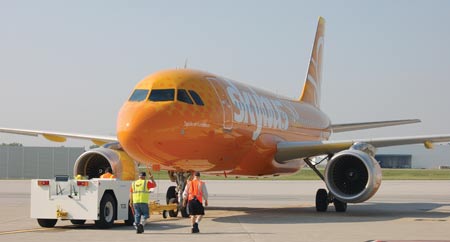More trees are falling in the forest that is the US airline industry, chopped by the ever sharper edge of the fuel price cleaver. The latest carriers to fold their wings and shut down are ATA Airlines and Skybus Airlines, both of which ceased operations in the first week of April. ATA lost a key charter contract, making futile its search for new funding to meet the demands of the pump. Skybus, which plans to file for Chapter 11 today, also blamed rising fuel prices and a slowing economy. The death of these two airlines comes just days after another carrier with a long history and a well-known name, Aloha Airlines, shut down suddenly.
All have blamed the rising spire of oil prices as well as competitive pressures. MIT airline project director Bill Swelbar says: "ATA and Aloha, each had a unique situation and a small footprint, but their closings clearly mean that there is more to come in the reshaping of the US industry, whether it's by liquidation or through mergers and acquisitions. And we're only at 'A' in the list of airlines."
* Aloha Airlines files for Chapter 11 bankruptcy protection on 20 March, shuts down passenger operations on 31 March * Champion Air announces it will cease flight operations on 31 May * ATA Airlines files for Chapter 11, discontinues passenger operations on 3 April * Skybus Airlines ceases operations 4 April * IATA downgrades 2008 industry profit forecast for the second time |
|---|
Although ATA operated only 29 jets, it had a long history and was an early proponent of a blending of the low-fare model with the network model. But ATA had gradually retreated from the low-fare scheduled business as it increasingly came to rely on charter business and on effective "virtual charters" it operated as codeshares for Southwest Airlines. Much like Aloha, it had gone through a bankruptcy from which it emerged as private carrier in late 2004. Aloha stumbled through a reorganisation that lasted 14 months. In February 2006, it was taken into private ownership by California supermarket millionaire Ron Burkle's Yucaipa Company. But Yucaipa, like ATA's parent, Global Aero Logistics, could not balance the books to pay the fuel bill, and each faced a new and tough competitive challenge.
At ATA, the challenge came when one of its major charter customers, FedEx, announced it would not be renewing ATA's military charter sub-contract for the next US government fiscal year, which begins in October. ATA said the contract was supposed to last another year. ATA had already trimmed its scheduled service dramatically, announcing a month ago that it would end all service at Chicago Midway, the airport it had made synonymous with low fares, and would also end its West Coast/Hawaii service in June. Southwest, which said its arrangements with ATA also ended on 4 April, had expanded its Midway presence significantly by buying ATA gates at the airport.
 At Aloha, the threat was fuel prices exacerbated by a new competitor, Mesa Air Group's very low fares intra-island carrier go! Since it started in June 2006 Go! had eroded a steady source of profit for Aloha, the market among the Hawaiian Islands, while the high cost of fuel had made Aloha's flights to California unprofitable. Aloha filed for bankruptcy for the second time on 20 March and after failing to win new support from Yucaipa or anyone else, shut down on 31 March.
At Aloha, the threat was fuel prices exacerbated by a new competitor, Mesa Air Group's very low fares intra-island carrier go! Since it started in June 2006 Go! had eroded a steady source of profit for Aloha, the market among the Hawaiian Islands, while the high cost of fuel had made Aloha's flights to California unprofitable. Aloha filed for bankruptcy for the second time on 20 March and after failing to win new support from Yucaipa or anyone else, shut down on 31 March.
George Hamlin, a consultant with ACA Associates, called Hawaii "a microcosm of the US market: a duopoly of Aloha and the larger Hawaiian Airlines in a market that could not sustain the entry of an additional carrier in this fuel-price environment". Hamlin thinks other airline failures are entirely possible. The larger US carriers may have enough cash for the year, says Calyon Securities analyst Ray Neidl, but "if high fuel prices and a lacklustre economy persist through 2009, cash reserves at many airlines might become a concern".
Fuel price sensitivity analysis, percentage of EBITDA | ||
|---|---|---|
2008E | 2009E | |
| Major carriers | ||
| AMR Corp | 5.7% | 4.8% |
| Continental | 5.6% | 4.1% |
| Delta | 2.9% | 2.6% |
| Northwest | 3.2% | 2.9% |
UAL Corp | 6.6% | 2.9% |
| US Airways | 31.9% | 6.8% |
| Low-cost carriers | ||
| AirTran Holdings | 6.7% | 5.2% |
| Alaska Air Group | 2.9% | 2.7% |
| Frontier | NM | 19.7% |
| JetBlue | 2.5% | 2.4% |
| Southwest | 0.9% | 1.5% |
NOTES: E=Estimate. NM=Not meaningful. Assume no revenue impact and that any increase or decrease in oil price passes through fully to jet. SOURCE: Calyon Securities (USA) Inc. | ||
Elsewhere in the USA, Sun Country said it would furlough 45 of its 156 pilots for the summer in a 30% cutback forced on it by the cost of fuel. The decision was made by the privately held low-cost carrier's new chief executive, former AirTran chief financial officer Stan Gadek.
The pain is not only being felt in the US airline market, but also on a more global scale. IATA recently downgraded its industry profit forecast for 2008 for the second time, citing a slowing economy and high oil prices. IATA is now predicting industry profits of $4.5 billion for the full-year. In September 2007 the prediction had been $7.8 billion, which was downgraded to $5 billion in December of that year.
"The broadening impact of the US credit crunch has brought buoyant consumer confidence to an abrupt end," says IATA director general Giovanni Bisignani. "Oil prices continue to rise. Demand is softening and after the 64% improvement in labour productivity and an 18% reduction in non-fuel unit cost attained since 2001, efficiency gains are much more difficult to achieve."
There are also early signs from the Asia-Pacific region that the downturn is starting to have an impact on aircraft lease rates. Patee Sarasin, chief executive of Thai low-cost carrier Nok Air - which is seeking next-generation Boeing 737s to replace its 737-400 fleet - says narrowbody lease rates have started to come down. "Leasing companies are more flexible now because they see the downturn coming," says Patee. "Four months ago we were looking at next-generation [737s] and people were saying 'you have to wait a long time'. Now we're getting a lot of offers." Patee adds that Nok is receiving proposals from leasing companies offering new 737-800s at 20% lower rates than a few months ago. He expects more aircraft to become available and lease rates to drop further as distressed carriers, such as the latest US casualties, offload aircraft, or defer or cancel new aircraft deliveries.

Source: Airline Business
















